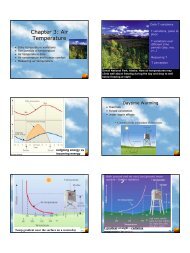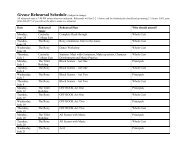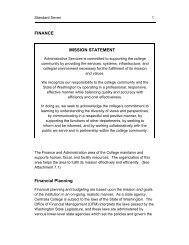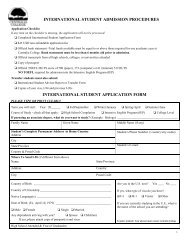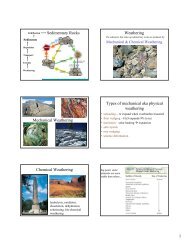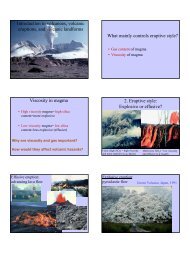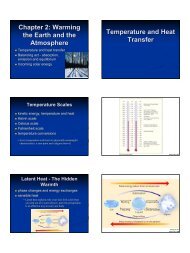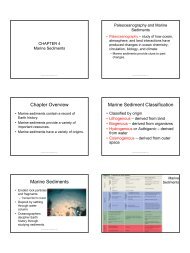Chapter 19 Shorelines and Coastal Processes Coastal Processes ...
Chapter 19 Shorelines and Coastal Processes Coastal Processes ...
Chapter 19 Shorelines and Coastal Processes Coastal Processes ...
- No tags were found...
You also want an ePaper? Increase the reach of your titles
YUMPU automatically turns print PDFs into web optimized ePapers that Google loves.
<strong>Chapter</strong> <strong>19</strong><strong>Shorelines</strong> <strong>and</strong> <strong>Coastal</strong><strong>Processes</strong><strong>Coastal</strong> <strong>Processes</strong><strong>and</strong> Terrain<strong>Coastal</strong> <strong>Processes</strong>Waves, tides, longshore drift, seasonal <strong>and</strong>decadal-scale changes, dunes, mass wasting<strong>Coastal</strong> L<strong>and</strong>formsDepositional: spits, baymouth bars, barrierbars, tombolosErosional: headl<strong>and</strong>s, sea stacks, arches,marine terraces, wave-cut benchesShore-Shaping Forces• Waves• Changes in Water Level• Tides• Stream Outflow• Ice Push• Organic Secretions•ErosionSea Waves• Due to wind blowing across water• Wave motion– wave length– wave height– circular motion in deep water– wave base- no motion below this depth– motion in shallow water- elliptical• causes surfFigure 20-4Waves
Development of WavesIdealized Beach ProfileFigure 20-2Figure 20-14TidesNormal High TidesFigure 20-8Figure 20-A(1)
Spring <strong>and</strong> Neap TidesHighest Tidal RangesFigure 20-BWave RefractionFigure 20-5StreamOutflowtomboloFigure 20-9
<strong>Coastal</strong> L<strong>and</strong>forms• Depositional L<strong>and</strong>forms–Beaches– Barrier Isl<strong>and</strong>s/Lagoons–Spits• <strong>Shorelines</strong> of Submergence– Fjorded Coasts– Wave-Cut Cliffs <strong>and</strong> Platforms– Marine Terraces• Coral CoastsS<strong>and</strong> Drift• Surf zone• Longshore currents– due to waves striking coast at an angle•Spit• Baymouth bar• Effects of blocking transportWave refractionThe effects of groins <strong>and</strong> littoral (longshore) drift
…jetties can have the same effect!Barrier Isl<strong>and</strong>sRequaPointView to southPhoto by John WhitmerView to northPhoto by John Whitmer
Photo by John WhitmerPhoto by John WhitmerPhoto by John WhitmerPhoto by John WhitmerBarrier Isl<strong>and</strong>s <strong>and</strong> LagoonsPhoto by John Whitmer
SpitsErosionFigure 20-18Formationof aWave-CutNotchWave-Cut NotchFormation of ArchesFigure 20-6
Marine Terrace DevelopmentFigure 20-24Coral CoastsCoral Reefs of the WorldFigure 20-27Figure 20-25Fringing ReefsBarrier Reefs <strong>and</strong> Atolls
Photo by John WhitmerPhoto by John WhitmerPhoto by John Whitmer<strong>19</strong>.2 How do waves form <strong>and</strong> move in water?Tsunami coming to shore in Thail<strong>and</strong>, Dec. 2004. These curiousunfortunates went to explore the exp<strong>and</strong>ed beach as the troughexposed it. The crest is seen in the background.Photo by John WhitmerFig 11.12
• Earthquakes <strong>and</strong> Tsunami– Motion along sub-sea faultdisplaces crust.– Rapidly displaced crust moveswater.– The Dec. 2004 event picturedpreviously displaced ocean floor,<strong>and</strong> the sea above, by 5 metersover an area approximately 400km long by 50 km wide.– Displaced water mass was ~100billion metric tons.– Such high energy input creates awave of very long wavelength<strong>and</strong> low wave height. Thus, theyare difficult to “see” in the openocean, yet the wave energy isvery fast.• Tsunami can also be caused byundersea mass movements.<strong>19</strong>.2 How do waves form <strong>and</strong> move inwater?Tsunami have a very deepwave base, <strong>and</strong> begin tobreak well offshore. Theinshore deceleration <strong>and</strong>wave crest buildup areboth very large as a result.Fig <strong>19</strong>.11Fig <strong>19</strong>.12<strong>19</strong>.5 Why does shoreline location changethrough time?Uplift <strong>and</strong> subsidence along the Oregon coast. Two surveys, 57 yearsapart, show marked vertical change along the entire coast of the state.<strong>19</strong>.6 How do we know ... that global sealevel is rising?100 years of tide gage data for NYC indicate a definite trend in sea level.This could, of course, indicate the l<strong>and</strong> is subsiding (as it measuresrelative sea-level change), but generally geologists try to avoid using datafrom known, tectonically active or otherwise vertically active locations.Data that doesinclude uplift ordownwardmovement can beadjusted to astable point,however.Fig <strong>19</strong>.41Fig <strong>19</strong>.44<strong>19</strong>.6 How do we know ... that global sealevel is rising?Geologists use coral as “dipsticks” of former sea levels, as theyare often very limited in the depth they can survive. Acroporapalmata is one such species <strong>and</strong> lives up to 5 meters depth. Oldcoral reefs found at 120 meters down indicates a change in sealevel.<strong>19</strong>.6 How do we know ... that global sealevel is rising?Using carbon-14 dating techniques, scientists are able toaccurately date the corals. They show a clear relation of depth totime. Other similar data sets have been collected <strong>and</strong> supportthese results.Fig <strong>19</strong>.45Fig <strong>19</strong>.45
<strong>19</strong>.7 What are the consequences ofrising sea level?Low-lying isl<strong>and</strong>s such as theFlorida Keys would all butdisappear with a two-meterincrease of sea level.<strong>19</strong>.7 What are the consequences ofrising sea level?Sea-level rise would cause a net loss of beach area due to erosion.On average, 1 cm of rise equals 1.5 meters of l<strong>and</strong>ward incursion.Fig <strong>19</strong>.47Fig <strong>19</strong>.46Fig 11.29<strong>19</strong>.7 What are the consequences of risingsea level?• Barrier isl<strong>and</strong> effects– Higher waves from risingseas wash s<strong>and</strong> acrossisl<strong>and</strong>.– Isl<strong>and</strong> migrates shoreward.– Isl<strong>and</strong>s merge with shoreafter filling lagoon.– Full wave effects arethereafter felt on shore.– Geologists find lagoondeposits indicating this hasoccurred in the past.<strong>19</strong>.7 What are the consequences ofrising sea level?Fig <strong>19</strong>.49• Estuary effects– For an estuary to persist,sea-level rise must exceedsedimentation from river.– Submergence of wetl<strong>and</strong>s(pictured 50 years apart)– In a natural system, tidalflats <strong>and</strong> salt marsheswould move inl<strong>and</strong>. Withhumans in the environmentthis does not occur.Fig 11.29 Fig <strong>19</strong>.48Fig <strong>19</strong>.52• What do we do? Thereare three generalresponses.– Armor the shoreline(seawalls, rip-rap, boulders,various deflectors)– Add sediment to erodingbeaches to maintain them– Ab<strong>and</strong>on the coastNote that armoring, suchas seawalls, protectsspecific property but doesnot save the beach or stoperosion.





